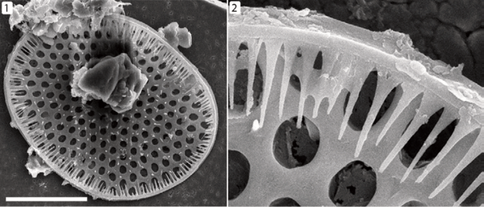2013 Annual Science Report
 Massachusetts Institute of Technology
Reporting | SEP 2012 – AUG 2013
Massachusetts Institute of Technology
Reporting | SEP 2012 – AUG 2013
Life and Environments: Fossils of the Late Meso- and Early Neoproterozoic
Project Summary
Any understanding of the major biological, biogeochemical and climatic events that characterized the late Neoproterozoic Era (ca. 750-541 million years ago) requires that we understand the state of Earth biota and environment as the critical interval began. Members of the Knoll lab have discovered and analyzed a series of fossil assemblages deposited between 1100 and 800 million years ago and continued to show the relationship between evolution and environmental change on the early Earth.
Project Progress
Members of the Knoll lab focused on the paleontological record of the late Mesoproterozoic and early Neoproterozoic eras, as well as the early record of complex multicellular organisms. 1100-1200 million year old successions from the Angmaat Formation, Baffin Island, contain exceptionally preserved microfossils in early diagenetic cherts nodules within peritidal carbonates. Five distinctive microbial assemblages can be differentiated, and these map one-to-one onto microbialite fabrics preserved in both silicified and non-silicified carbonates. This demonstrates that under favorable circumstances, stromatolites can preserve a record of microbial community diversity in preserved petrographic fabrics. This, in turn, sharply improves our ability to draw biological inferences from the Proterozoic stromatolite record (Knoll et al., 2013). In ca. 800 million year old carbonates from the Fifteen Mile Group, northwestern Canada, Cohen and Knoll (2012) documented remarkably preserved scale microfossils that provide the most diverse record of eukaryotic life yet discovered in rocks older than the Ediacaran Period. The scales record evolving defenses against protistan predation, supporting the hypothesis that expanding predation by eukaryotes on eukaryotes fueled Neoproterozoic protistan diversification (Knoll, in press). In related research, Ratti et al. (2013) reported the results of experiments that show how evolving eukaryophagic predators could have changed patterns of primary production, favoring eukaryotic algae over cyanobacterial phytoplankton. Knoll’s group also discovered probable microfossils in metamorphosed Neoproterozoic shales from the Dalradian Supergroup, Scotland (Anderson et al., 2013).
In related work on early animals, Knoll’s group linked the latest Neoproterozoic oxygen rise and the ecological drivers of Cambrian animal diversification, showing via meta-analysis of ecological data from oxygen minimum zones in the ocean that relatively high oxygen tensions are required to support carnivory (Sperling et al., 2013). The group also completed stratigraphic and geochemical research showing how the distinctive redox conditions of Ediacaran and Cambrian oceans help explain the exceptional fossil preservation by phosphate mineralization in beds of this age (Creveling et al., in press and submitted). Finally, Knoll and his colleagues completed critical reviews of stromatolites (Bosak et al., 2013), early eukaryotic evolution (Knoll, in press), early microbial evolution (Knoll, submitted), the evolutionary relationship between animals and microbes (McFall-Ngai et al., 2013), and the physiological links between geological records of biological and environmental change (Knoll, 2013).
Publications
-
Anderson, R. P., Fairchild, I. J., Tosca, N. J., & Knoll, A. H. (2013). Microstructures in metasedimentary rocks from the Neoproterozoic Bonahaven Formation, Scotland: Microconcretions, impact spherules, or microfossils?. Precambrian Research, 233, 59–72. doi:10.1016/j.precamres.2013.04.016
-
Bosak, T., Knoll, A. H., & Petroff, A. P. (2013). The Meaning of Stromatolites. Annual Review of Earth and Planetary Sciences, 41(1), 21–44. doi:10.1146/annurev-earth-042711-105327
-
Cohen, P. A., & Knoll, A. H. (2012). Scale Microfossils from the Mid-Neoproterozoic Fifteenmile Group, Yukon Territory. Journal of Paleontology, 86(5), 775–800. doi:10.1666/11-138.1
-
Creveling, J. R., Johnston, D. T., Poulton, S. W., Kotrc, B., Marz, C., Schrag, D. P., & Knoll, A. H. (2013). Phosphorus sources for phosphatic Cambrian carbonates. Geological Society of America Bulletin, 126(1-2), 145–163. doi:10.1130/b30819.1
-
Knoll, A. H. (2012). Systems paleobiology. Geological Society of America Bulletin, 125(1-2), 3–13. doi:10.1130/b30685.1
-
Knoll, A. H., Worndle, S., & Kah, L. C. (2013). COVARIANCE OF MICROFOSSIL ASSEMBLAGES AND MICROBIALITE TEXTURES ACROSS AN UPPER MESOPROTEROZOIC CARBONATE PLATFORM. PALAIOS, 28(7), 453–470. doi:10.2110/palo.2013.p13-005r
-
Ratti, S., Knoll, A. H., & Giordano, M. (2013). Grazers and Phytoplankton Growth in the Oceans: an Experimental and Evolutionary Perspective. PLoS ONE, 8(10), e77349. doi:10.1371/journal.pone.0077349
- Knoll, A.H. (2013, In Press). Paleobiological perspectives on early eukaryotic evolution. In: Koonin, E. & Keeling, P. (Eds.). Origin and Evolution of Eukaryotes. Cold Spring Harbor Laboratory Press.
- Knoll, A.H. Paleobiological perpsectives on early microbial evolution. Cold Spring Harbor Laboratory.
-
PROJECT INVESTIGATORS:
-
PROJECT MEMBERS:
Andrew Knoll
Project Investigator
Tanja Bosak
Co-Investigator
Phoebe Cohen
Co-Investigator
David Johnston
Co-Investigator
Ross Anderson
Collaborator
Jessica Creveling
Collaborator
Mario Giordano
Collaborator
Peter Girguis
Collaborator
Linda Kah
Collaborator
Benjamin Kotrc
Collaborator
Lisa Levin
Collaborator
Simon Poulton
Collaborator
Simona Ratti
Collaborator
Daniel Schrag
Collaborator
Erik Sperling
Collaborator
-
RELATED OBJECTIVES:
Objective 4.1
Earth's early biosphere.
Objective 4.2
Production of complex life.
